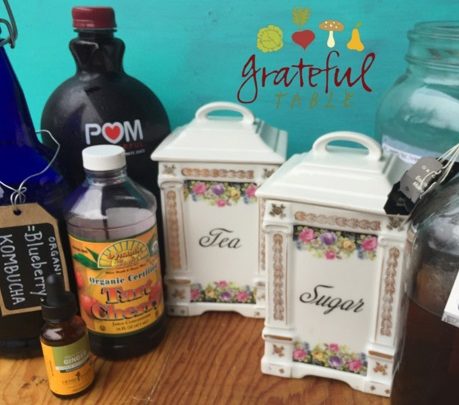I think kombucha brewing is similar to mothering. There is new-mom style, for the woman with her first baby, treating her newborn ever so delicately, trying to keep everything perfect… And then there’s the seasoned mom (or grandma), whose mothering has become much more relaxed over the years. Kombucha brewing should be so easy, which you realize after you’ve done it awhile, and see it survive many adverse conditions!
 After doing this for a few years, I’ve developed a simple method. If you want more detailed directions, check out “Kombucha Continuous Brew Method”. But below are easy tea directions, for making some in a medium-large glass jar (approximately 2.5 quart size). I like using something larger than a quart jar, so I can make a larger or smaller batch, depending on the status of my kombucha reserves.
After doing this for a few years, I’ve developed a simple method. If you want more detailed directions, check out “Kombucha Continuous Brew Method”. But below are easy tea directions, for making some in a medium-large glass jar (approximately 2.5 quart size). I like using something larger than a quart jar, so I can make a larger or smaller batch, depending on the status of my kombucha reserves.
PS My most favorite probiotic drink is “Jun Kombucha”- directions for that here!
INGREDIENTS
- 2-3 tea bags (or 1/2 TBS. loose black tea)
- 4 c. boiling water
- 1/4 c. sugar
- 1-2 c. starter tea (the more used, the quicker the ferment)
Brew new tea in a tea pot, if desired, although any thermal coffee flask is easier to clean out when using loose tea.
Add: > 2-3 tea bags (or 1/2 TBS. loose black tea) > 4 c. boiling water
Let tea brew for 10 minutes or so (longer if desired). Then pour the tea into another jar, straining out loose tea. Add and stir in: > 1/4 c. sugar
After tea has cooled, add to the komucha-brewing jar. That jar should have around a cup or two of starter tea in it, plus the scoby. (Strain that liquid once in awhile, to remove brown tendrils or sediment.)
I don’t even stir the mix of old and new- it seems to mix enough when pouring in. Let it brew for a week or two, to taste.
Decant some of the finished kombucha into carbonating-style bottles (with the spring-clamp and rubber gasket). These home-brewing bottles are less of an investment (two 16-oz. bottles), but I went all out and invested in a case of big 32-oz. bottles, and was glad I did.
To the bottled kombucha, also add a cup or two of a favorite organic juice, if desired, or ginger or other flavorings. I’m a stickler for using organic- a lot of produce, like apples, are on the dirty dozen list, full of pesticides. Some of my favorites for flavoring kombucha (and kefir) are POM pomegranate juice, organic apple or grape juice (at TJ’s), or this Tart Cherry Juice Concentrate. (The concentrated cherry juice might seem expensive, but it takes 53 lbs. of produce to yield 1 lb. of juice!) This black cherry juice concentrate is also a good one.
I used to use fresh ginger, sliced into match-sized strips, laid out on foil, rolled up, and frozen, to be used as needed. (If I didn’t do this, the chunk of ginger would often get too dried and/or moldy, sitting out…) Now I often add “Ginger Bug” to my kombucha–it’s so good, and makes it extra fizzy!
Techie talk: The enzymes and yeasts in the kombucha will use the minerals from the tea to break down the sugar into glucose and fructose. So, after a week or so, the sugar’s still there, but in an easier-to-digest form. But it’s still pretty sweet! Usually, after another week or two, beneficial acids will start forming as the yeasts start eating the sugars up. But there will still be some sweetness, for up to 30 days or so.
To some up some time-saving pointers:
- Brew your tea right in a thermal flask
- Strain the cooled, sweet tea right into the kombucha jar, after decanting some of your fermented kombucha
- Put some of the new mix straight into a carbonating bottle along with some fruit juices, to do its first ferment and finishing carbonation all in one place. (This will take at least 2 weeks.)
Give kombucha about 7 days to get the first fermentation going, after adding more sweet tea. Then, decant if desired (or let it go longer), and give it another 14-21 days to finish, in bottles, which will build up fizz. After 14-21 days, it will have the most beneficial acids.
Note: Check any fermenting bottles every few days or so. “Burp” the bottle by popping the lid- the amount of “pop” will tell you how fermented it is. Regular kombucha generally doesn’t build up too much fizz, but Jun Kombucha… well, that’s another story!
Happy brewing!

One Response to “Kombucha: Easy Recipe (Once You Have Scoby)”